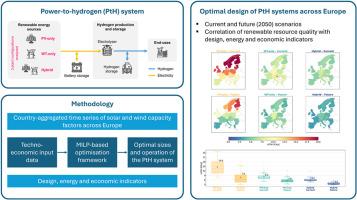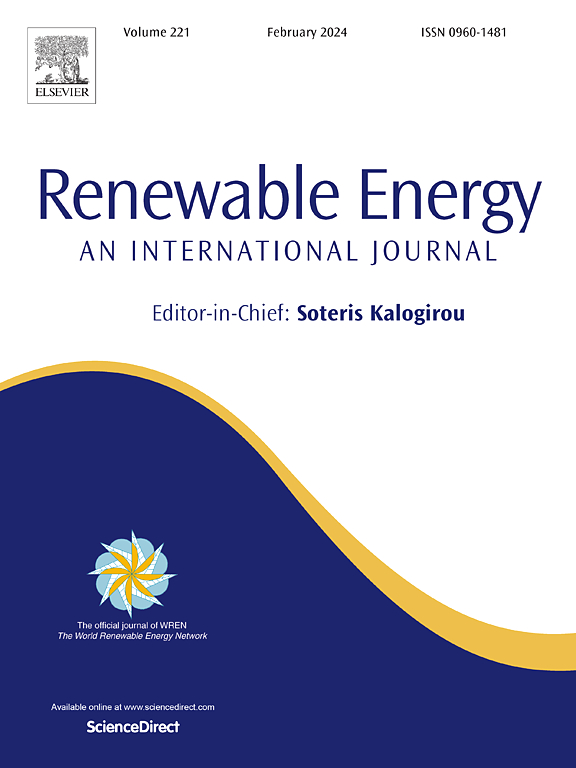Optimising green hydrogen production across Europe: How renewable energy sources shape plant design and costs
IF 9.1
1区 工程技术
Q1 ENERGY & FUELS
引用次数: 0
Abstract
Green hydrogen is widely recognised as a key enabler for decarbonising heavy industry and long-haul transport. However, producing it cost-competitively from variable renewable energy sources presents design challenges. In this study, a mixed-integer linear programming (MILP) optimisation framework is developed to minimise the levelised cost of hydrogen (LCOH) from renewable-powered electrolysers. The analysis covers all European countries and explores how wind and solar resource availability influences the optimal sizing of renewable generators, electrolysers, hydrogen storage, and batteries under both current and future scenarios. Results show that renewable resource quality strongly affects system design and hydrogen costs. At present, solar-only systems yield LCOH values of 7.4–24.7 €/kg, whereas wind-only systems achieve lower costs (5.1–17.1 €/kg) due to higher capacity factors and reduced storage requirements. Hybrid systems, combining solar and wind, emerge as the most cost-effective solution, reducing average LCOH by 57 % compared to solar-only systems and 25 % compared to wind-only systems, effectively narrowing geographical cost disparities. In the future scenario, LCOH declines to 3–4 €/kg, confirming renewable hydrogen's potential to become economically competitive throughout Europe. A key contribution of this work is the derivation of design guidelines by correlating renewable resource quality with technical, energy and economic indicators.

优化整个欧洲的绿色氢气生产:可再生能源如何影响工厂设计和成本
绿色氢被广泛认为是重工业和长途运输脱碳的关键推动者。然而,从可变的可再生能源中生产具有成本竞争力的太阳能带来了设计上的挑战。在本研究中,开发了一个混合整数线性规划(MILP)优化框架,以最大限度地降低可再生动力电解槽的氢(LCOH)的平准化成本。该分析涵盖了所有欧洲国家,并探讨了风能和太阳能资源的可用性如何在当前和未来的情况下影响可再生能源发电机、电解槽、储氢装置和电池的最佳规模。结果表明,可再生资源质量对系统设计和氢成本有很大影响。目前,纯太阳能系统的LCOH值为7.4-24.7欧元/公斤,而纯风能系统的成本更低(5.1-17.1欧元/公斤),因为容量系数更高,存储需求更少。结合太阳能和风能的混合系统是最具成本效益的解决方案,与太阳能系统相比,平均LCOH降低了57%,与风能系统相比,平均LCOH降低了25%,有效地缩小了地域成本差距。在未来的情景中,LCOH将下降到3-4欧元/公斤,这证实了可再生氢在整个欧洲具有经济竞争力的潜力。这项工作的一个关键贡献是通过将可再生资源质量与技术、能源和经济指标联系起来,推导出设计准则。
本文章由计算机程序翻译,如有差异,请以英文原文为准。
求助全文
约1分钟内获得全文
求助全文
来源期刊

Renewable Energy
工程技术-能源与燃料
CiteScore
18.40
自引率
9.20%
发文量
1955
审稿时长
6.6 months
期刊介绍:
Renewable Energy journal is dedicated to advancing knowledge and disseminating insights on various topics and technologies within renewable energy systems and components. Our mission is to support researchers, engineers, economists, manufacturers, NGOs, associations, and societies in staying updated on new developments in their respective fields and applying alternative energy solutions to current practices.
As an international, multidisciplinary journal in renewable energy engineering and research, we strive to be a premier peer-reviewed platform and a trusted source of original research and reviews in the field of renewable energy. Join us in our endeavor to drive innovation and progress in sustainable energy solutions.
 求助内容:
求助内容: 应助结果提醒方式:
应助结果提醒方式:


